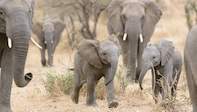

The full report is published June 27 in the open access journal PLoS ONE. Authors of the study, led by Patricia Birkett of the Amarula Elephant Research Programme at the University of Kwazulu-Natal in South Africa, investigated the correlation between elephant movements and rainfall by tracking the movement speed of 14 female elephants in Kruger National Park (KNP) from 2006 to 2010. They looked at how elephant patterns change due to seasonal changes in rainfall.
They found that the speed changed sharply at the end of both the wet and dry seasons each year, suggesting that movement patterns could provide an objective definition of seasonal boundaries. Birkettt explains, "These seasonal boundaries are relevant to the specific aspects of the environment that we are interested in understanding or managing." The study ran over five 'clusters' in the KNP, based on the area in which they were collared - Orpen-Skukuza, Satara-Nhlanguleni-Muzanduzi, Lower Sabie, Satara and Skukuza.
The researchers collared 14 elephants in total. "The collars were set to record locations at 30 min intervals." The idea is to examine the elephants' behaviour to find ecologically significant milestones over time. The aim was to determine a timeline over which the changes in the elephants' movement patterns can be detected. "We then examine whether these shifts in elephant movement can be related to rainfall patterns at local and regional scales."
Findings
The researches found that "the timing of our seasons is biologically relevant to the species, and does not depend on coarse-scale measures of an external variable which may not reflect the true variation in the species' behaviour.
Examination of elephant movement patterns in conjunction with rainfall patterns indicated that all herds changed their behaviour at two distinct thresholds: at the end of the dry season before the first rains commenced, and at the end of the wet season, during the period of the highest average daily rainfall.
These changes coincided with the major rainfall breakpoints, which signal a seasonal transition between wet and dry, and dry and wet periods."
In general, elephant in KNP increased their speed during the wet season (summer months) up until a maximum threshold point at the onset of the dry season, following which their speed reduced, until a minimum threshold point at the end of the dry season.
Beyond this point, at the onset of the wet season, their speed increased once more. The lower breakpoints indicate that a change from dry to wet season conditions triggered a release from constrained movement behaviour, which is consistent with the 'dry season bottleneck' theory proposed for herbivores in environments where there are markedly different seasons.
Herbivores are restricted during dry periods, since both forage quality and quantity are reduced; however, there is a release from these constraints once the wet season commences."

 The African Elephant is the world's largest land mammal, and weighs up to 7 tonnes and reaches heights of 3.3 m at the shoulder. Where are E...
The African Elephant is the world's largest land mammal, and weighs up to 7 tonnes and reaches heights of 3.3 m at the shoulder. Where are E...